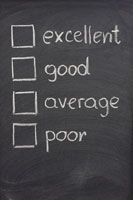 The US News and World Report Best College Rankings is considered by many high school students and their parents to be the final word on a college’s desirability. Not surprisingly, many others believe that the rankings represent everything that is wrong with college admissions today. The reality is that the rankings are made up of numbers and it is up to individuals to decide how to use those numbers. For those considering using the rankings, you should be aware of the following.
The US News and World Report Best College Rankings is considered by many high school students and their parents to be the final word on a college’s desirability. Not surprisingly, many others believe that the rankings represent everything that is wrong with college admissions today. The reality is that the rankings are made up of numbers and it is up to individuals to decide how to use those numbers. For those considering using the rankings, you should be aware of the following.
1. For the 2014 rankings, US News increased the value of graduation rates from 16% to 18%. This means that for National Universities and Liberal Arts Colleges graduation rates combined with the freshman retention rate, 4.5%, equal in weight to that of the undergraduate reputation of 22.5%. If you add in the 7.5% for graduation rate performance, then graduation rates weight more heavily.
Despite the increase in the weight of graduation rates, reputation still plays a big role in the rankings.
Two-thirds of the reputation is determined by a peer assessment survey. And if this brings to mind some sort of virtuous ivory tower academic carefully considering the merits of each school, think again.
According to the methodology :
In order to reduce the impact of strategic voting by respondents, we eliminated the two highest and two lowest scores each school received before calculating the average score.
In other words, they’re having serious problems with schools gaming the system to improve their rankings. But hey, if the opinion of such people are important to you, these are the rankings to use.
I would love to see the rankings with the academic reputation part removed. Not that I think the schools in the top 100 or so would change dramatically, but the I think there would be some interesting changes in the order.
2. The Top 50 colleges in the US News Best College Rankings National University and National Liberal Arts categories combine to account for just under nine percent of all full-time undergraduates in the country. If you want to claim you’re attending a top 10% school, going to one of these schools would fit the bill.
3. Four states dominate the rankings: California, Massachusetts, New York, and Pennsylvania. They accounted for 27 of the 50 National Liberal Arts colleges and 26 of the 50 National Universities. Maybe they should consider exporting their water.
But then again, these four states rank in the top five states for the most number of four-year colleges. The missing state? Texas.
4. The only public schools in the top 50 Liberal Arts Colleges rankings are the military academies.
5. The US News Best College rankings tables are showing the six-year graduation rate, not the four-year graduation rate. How long do you plan to take to graduate?
6. The highest four-year graduation rate for the top 50 Liberal Arts Colleges was 91%, the lowest was 63%. For the top 50 National Universities, the range was from 90% to 48% (Georgia Tech which has an extensive engineering cooperative program has a four-year rate of only 31% but its five-year rate is 72%). There are 350 colleges not in the top 50 of either list with four-year graduation rates higher than 48%
7. Three of the top 50 US News Best Liberal Arts colleges and five of the National Universities admitted half of their applicants. A total of 21 institutions admitted 40% or more of their applicants, 12 National Universities and 9 Liberal Arts Colleges.
8. The average percentage of freshman with Pell Grants is 15.8% at the top 50 Liberal Arts Colleges and 18.4% for the top 50 National Universities. The average for the rest of the schools-48.4%
9. Some of the colleges on the top 50 lists are not good places to go to avoid student debt.? At Yeshiva University, 34% of freshman have non-federal student loans. Occidental and Mount Holyoke College led the Liberal Arts Colleges at 32% and 21% respectively.
Ten colleges have an average net price after gift aid of over $30,000. New York University has the highest at $36,834 followed by Oberlin College at $34,797. A total of 28 institutions had an average net price of less than $20,000 with only Georgia Tech below $10,000.
10. While it’s fairly easy to find the individual school’s common data set that is used to calculate these rankings, it’s not so easy to find their results from the National Survey of Student Engagement (NSSE).
The NSSE differs significantly from other rankings in that it focuses on the student experience in their first year and their senior year. In other words, it’s trying to capture what happens to the student during their four years on campus. Not surprisingly, few institutions make this information publicly available.
Of the schools in the two top 50 US News Best College Rankings national categories, 33 Liberal Arts Colleges and 14 National Universities participated in the survey in the last three years. Of the top 20 colleges in each category, Liberal Arts Colleges were much more likely to participate than National Universities. Eleven colleges among the top 20 Liberal Arts Colleges participated while only one National University in the top 20 participated, Emory.
With the exception of the actual rankings, all of the above data is from the Integrated Postsecondary Education Data System which is the source for the DIY College Rankings College Search Spreadsheet.

3 thoughts on “10 Things You Should Know About the US News Best College Rankings”